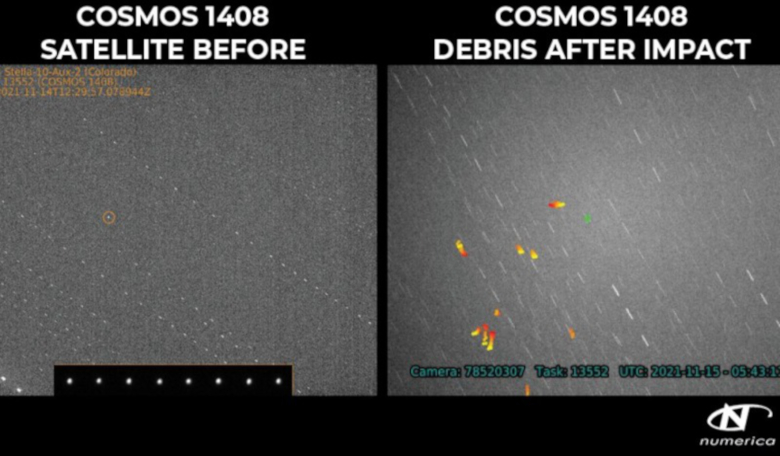Debris from a defunct satellite destroyed during a missile test carried out by Russia has now been spotted in space by Numerica Corp., a Colorado-based company that provides tracking of space debris objects.
This week, Russia has faced an outpouring of condemnation after the country admitted to destroying a 2,000 kilogram, former electronic and signals intelligence (ELINT) satellite launched by the Soviet Union in 1982.
With a reported lifespan of only 6 months, Kosmos-1408 had been circling the planet for the last 39 years until Russia shot it down during an antisatellite test (ASAT) on 15 November.
The test quickly prompted widespread criticism by government officials around the world, most notable the US, as debris from the satellite forced crew members onboard the ISS to take temporary shelter in return ships incase of an impending collision with the satellites shards.
“The test has so far generated over 1,500 pieces of trackable orbital debris and hundreds of thousands of pieces of smaller orbital debris that now threaten the interests of all nations”, US State Department spokesman Ned Price said.
Asked about the test’s impact on the ISS and its crew, Didier Schmitt, a senior figure at the European Space Agency (ESA) said; “it's difficult to say with hindsight. But what we know is that from now on, according to our sources, the risk of collision could be five times greater in the weeks, even the months ahead.”
The new debris is moving in the same orbit as the Station, which is to around 400 kilometres in altitude, at more than 8 kilometres a second, Schmitt said. “That's seven to eight times faster than a rifle bullet! So to avoid them you have to predict a long time in advance: you can raise or lower the ISS a little,” he added.
Although initially silent about the test, Russia later confirmed it took place, downplaying any hint of a problem. "It is true that we have successfully tested a cutting-edge system of the future. It hit an old satellite with precision worthy of a goldsmith”, said Russian Defense Minister Sergey Shoigu. But, he added, "the remaining debris pose no threats to space activity,"
Sue Gordon, former principal deputy director of US national intelligence, was candid about Russia’s noncommittal response. “No one understands the space environment as well as Russia does,” Gordon said during a Center for Strategic and International Studies online forum.
“So let’s not be confused about whether they didn’t understand the likely impact of their action,” she said. “These are very experienced space actors.”
Russia however hit back at its critics; “The United States knows for certain that the resulting fragments, in terms of test time and orbital parameters, did not and will not pose a threat to orbital stations, spacecraft and space activities," it said. Russian military officials also noted that such tests have been conducted in the past by other space-faring nations.
India for example faced a similar backlash in 2019 when fragments from its ASAT test were pushed into higher orbits than expected, meaning that the debris could have significantly longer orbital lifetimes.
According to the Secure World Foundation, an organisation devoted to space sustainability issues, the newly-created debris field will expand in size and spread in a ring around the Earth that will likely remain on orbit to threaten other space objects for years to come.
“Regardless of rationale, to deliberately create orbital debris of this magnitude is extremely irresponsible,” said SWF.
After lamenting Russia on the test, the Foundation also acknowleded that the country was not alone in its actions and called upon other major participants to work together to prevent further similar incidents. “We call upon the United States, Russia, China, and India to declare unilateral moratoriums on further testing of their antisatellite weapons that could create additional orbital debris and to work with other countries towards solidifying an international ban on destructive ASAT testing.”
Images of the debris have now been captured by Numerica Corp., a Colorado-based company provides tracking of space debris objects.
The footage shows just some of the more than 1,500 trackable pieces of debris from Cosmos-1408, although hundreds of thousands of pieces of smaller orbital debris are likely to remain undetected.
Because of the different alignment of the Earth, the ISS shouldn't pass through the same zone as the debris in the immediate future, Schmitt says. But, the great danger of the debris, is the domino effect. “The more debris you have, the more chance you have of hitting satellites, and so to blow others up and so on. At these speeds, any impact can be devastating.”











